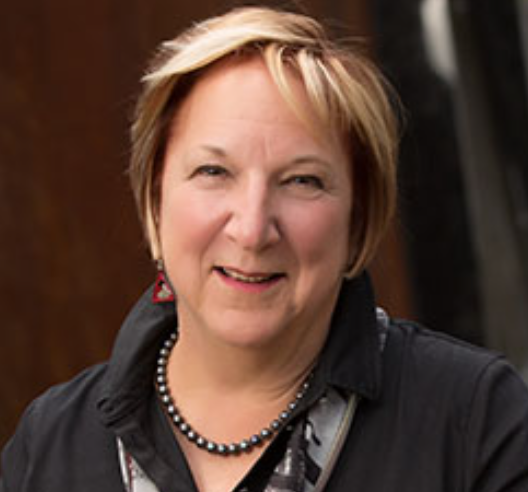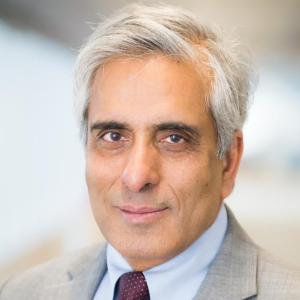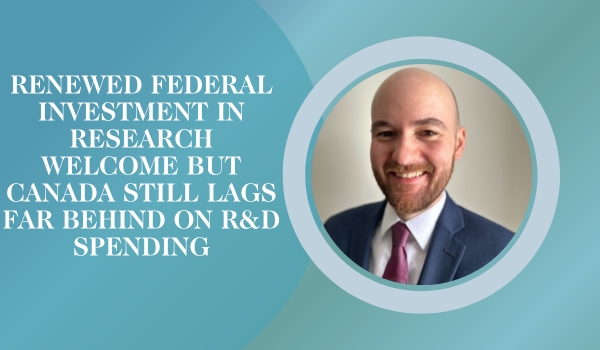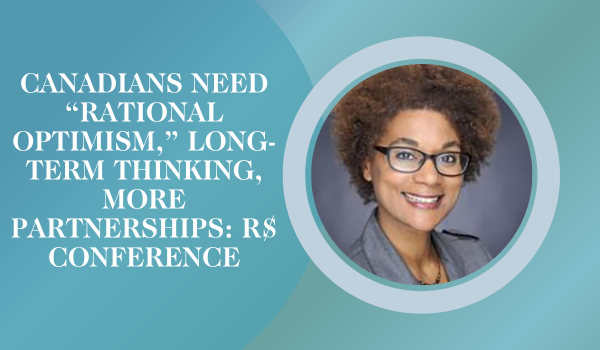Fewer “new shiny things,” more strategic programs needed to fix research and innovation ecosystem
Canada must fix its fragmented research and innovation ecosystem by focusing less on “new shiny things” and much more on strategic programs that create the future Canadian want, panelists said at Research Money’s 23rd annual conference in Ottawa.
They said a new capstone research funding organization and a new advisory council on science and innovation can help correct problems in the ecosystem, but only if they’re carefully designed and implemented, and made permanent no matter which political party is in power.
Both new initiatives – announced in federal Budget 2024 – were recommended in the report by the government-appointed Advisory Panel on the Federal Research Support System (the “Bouchard report”).
 “Governments do like new shiny things,” but every new shiny thing announced leads to fragmentation and ineffectiveness across the research and innovation ecosystem, said Janet Rossant (photo at right) president and scientific director of The Gairdner Foundation and who was a member of the Bouchard panel.
“Governments do like new shiny things,” but every new shiny thing announced leads to fragmentation and ineffectiveness across the research and innovation ecosystem, said Janet Rossant (photo at right) president and scientific director of The Gairdner Foundation and who was a member of the Bouchard panel.
There is fragmentation among the 130 different agencies that fund research and innovation in Canada, as well as fragmentation between the priorities and goals of research and innovation, she said at a R$ conference session titled "External Advice to Government: Lessons learned from the past."
Every funding agency likely has its own strategic plan, she added, but there’s no strategy linking and coordinating all the agencies, or an overarching federal government strategic plan for technology and innovation.
“It’s really important going forward that we really do try, as a society, to come together and say: What’s important for Canada? Where are the big issues we’re going to face in the future? What's the best organizations to deliver for the future?” Rossant said.
 The apparatus of research funding in Canada looks like “some engineering plumber’s map that has these pieces going in every direction,” said Martha Crago (photo at left), vice-principal (research and innovation) at McGill University.
The apparatus of research funding in Canada looks like “some engineering plumber’s map that has these pieces going in every direction,” said Martha Crago (photo at left), vice-principal (research and innovation) at McGill University.
“We have all kinds of bits and pieces that don’t always line up with each other,” she said. “And then these aren’t good investments, because we don’t know how to make them work together properly.”
External advisory bodies need to include some government people who know how government works and can help advisory groups understand the complexity of what they’re proposing, Crago said. This will help ensure research and innovation funding is spent in ways that are doable and make sense, she said.
Gisèle Yasmeen, associate vice-president, international, at the University of Ottawa, agreed that governments do like “the sexiness of announcing things, shiny objects.”
“The frank reality is that implementation is not sexy,” she said. “It’s hard work. It requires aligning a lot of different people and resources.”
A general problem is that Canada tends to have a “a satisfaction with mediocrity,” Yasmeen said. “We need to have the guts to collapse some of these [innovation] programs together.”
 Canada could learn from models in the U.S., such as the Defense Advanced Research Agency (DARPA) and the Small Business Innovation Research Program (SBIR), in improving the research and innovation ecosystem in this country, said Arvind Gupta (photo at right), professor of computer science at the University of Toronto.
Canada could learn from models in the U.S., such as the Defense Advanced Research Agency (DARPA) and the Small Business Innovation Research Program (SBIR), in improving the research and innovation ecosystem in this country, said Arvind Gupta (photo at right), professor of computer science at the University of Toronto.
He said members of the U.S. President’s Council of Advisors on Science and Technology have told him that programs like DARPA (created in 1958) and SBIR (established in 1982) have lasted so long because they’re too strategically important to the country to be made political. The independent advisory council to the president is comprised of distinguished individuals from industry, academia and non-profit organizations.
Gupta noted that the second-largest discretionary spend for Canada’s federal government is on research and innovation. “We are a big spender on research and innovation, with poor outcomes.”
Canada has a plethora of broad-based programs to support research and innovation, he said. “It’s not clear to me that we should keep putting more and more money into these programs. Do we have the will to say: Let’s start building those programs that are going to support winners.”
Assess whether current research and innovation spending is delivering value
Rossant said the new capstone research funding organization recommended in the Bouchard report wasn’t meant to add another layer of bureaucracy to the federal research support system.
Rather, one of the main roles of the new agency should be to evaluate how research and innovation funding is spent and whether programs are delivering value for money and a good return on investment, she said.
With the current federal research support system, “we have many, many different pots of money that are not necessarily well spent,” Rossant said.
“Agencies and funding vehicles get put in place and they have a life of their own,” she said. “They stay as a budget line item and they carry over,” and government just renews their funding.
The intent of the new capstone agency is to be strategic and deliver on mission-driven research, interdisciplinary research and international research, “and be in a situation where you can actually evaluate the best way to fund those,” Rossant said.
In contrast to Canada’s research funding approach, Crago noted that some counties such as Germany, South Korea and others provide consistent incremental funding year after year. These countries are some of the world’s best performers on R&D, she said.
“In the midst of the poly-crisis [a confluence of global risks facing Canada], we’re trying to solve something politically by budget by budget by budget,” Crago said.
Research funding needs to have a smoothness and reliability to it, she added, “because the world out there is intermittent and very fitful.”
The rest of Canada could learn from Quebec, which has a nimble and flexible way of funding research, including mission-driven research, Crago said.
Gupta pointed out that the National Science Foundation (NSF) in the U.S. doesn’t like programs which require matching funding from industry. That leads to too many short-term projects, whereas the NSF wants aspirational projects, he said.
In Canada, we’ve gotten into this mode of thinking that everything is about requiring matching funds, he said. “We’re too scared of picking winners and losers. So we say everybody will have exactly the same programs.”
He pointed out that Switzerland has eight world-leading companies, and there are similar global leaders in France, the Netherlands, Germany and other nations.
In contrast, nine of Canada’s top 10 companies in capital are protected industries of one type or another, such as those that are government regulated, or resource industries, or in the banking sector.
“Where are those great technology companies that are going out there and owning the world?” Gupta asked. “We have to have a whole sea-change in our mind. We’ve got to go for gold.”
“Put Canada first” in supporting research and innovation
Yasmeen said that in providing advice to government on research and innovation, it’s important to frame such advice effectively, so it can be acted upon within government.
So much of the advice now is framed around technological issues, she said, as opposed to addressing how we use the technology, how we design our institutions, what are our governance challenges, what leadership is required to make something happen, and what are the ethical dimensions.
Providing government with advice should be “about understanding the human condition and how do we make change happen in society. It goes well beyond a technological challenge,” Yasmeen said.
.jpg) Canada is missing seeing and planning for the longer-term horizons, said panel moderator Sandra Noel (photo at right), president and CEO at Dynovus Consulting Inc. “Let’s try to understand what is the society we’re trying to build, what is the future we’re trying to grow, and then work backwards from that – engineer that future.”
Canada is missing seeing and planning for the longer-term horizons, said panel moderator Sandra Noel (photo at right), president and CEO at Dynovus Consulting Inc. “Let’s try to understand what is the society we’re trying to build, what is the future we’re trying to grow, and then work backwards from that – engineer that future.”
Rossant said many of the G7 comparator countries to Canada have the equivalent of a science and innovation advisory council, including many bodies that are “very powerful and do have an impact on policy and funding.”
Gupta, who was a member for five years of the federal Science, Technology and Innovation Council (STIC), said STIC effectively brought all the players together.
Stephen Harper’s Conservative government established STIC in 2007, which then published periodic reports between 2009 and 2014 on the state of science, technology and innovation in Canada, based on international standards of excellence.
Justin Trudeau’s Liberal government ended STIC in 2016 and planned to replace it with the Council for Science and Innovation in fiscal year 2018-19, but that wasn’t done.
Rossant said the new advisory council has to have a high enough stature and impact “that it would be considered a big mistake for any government to take it away.” Also, she said, the advisory council and the new research funding capstone agency need to be very closely linked and work together.
Yasmeen said the advisory council needs to have a global perspective, not just Canadian. “We need a holistic perspective that cuts across federal-provincial jurisdictions.” The council also needs to include voices of younger people in their 20s and 30s, she added.
Gupta said U.S. advisory councils on science and technology and the economy are high-profile and their work is regularly covered by media.
Perhaps Budget 2024’s proposed new advisory council on science and innovation should be a prime ministerial council with more public reporting, including of “success stories,” so Canadians are aware the government is taking advice from knowledgeable people, he suggested.
“We want some permanent structure that’s constantly giving advice to government,” Gupta said.
There is an opportunity to work with government to try to shape what the new advisory council should look like, he said. However, he cautioned that if the council is a high priority, “then it’s really important to make that clear to government.”
Gupta pointed out that in the U.S., the Council of Economic Advisors, an agency within the Executive Office of the President, includes some of the country’s most influential CEOs.
They are told to think about their country first and their company second, and their advice to government doesn’t seem self-interested, he said.
“We should all think about [putting] Canada first, and not our own little parochial piece of some pie,” Gupta said. “That’s the kind of thinking we need at the macro-level. Somehow we have to get this notion that Canada comes first and that is a function of good governance.”
R$
Events For Leaders in
Science, Tech, Innovation, and Policy
Discuss and learn from those in the know at our virtual and in-person events.
See Upcoming Events
You have 0 free articles remaining.
Don't miss out - start your free trial today.
Start your FREE trial Already a member? Log in
By using this website, you agree to our use of cookies. We use cookies to provide you with a great experience and to help our website run effectively in accordance with our Privacy Policy and Terms of Service.





